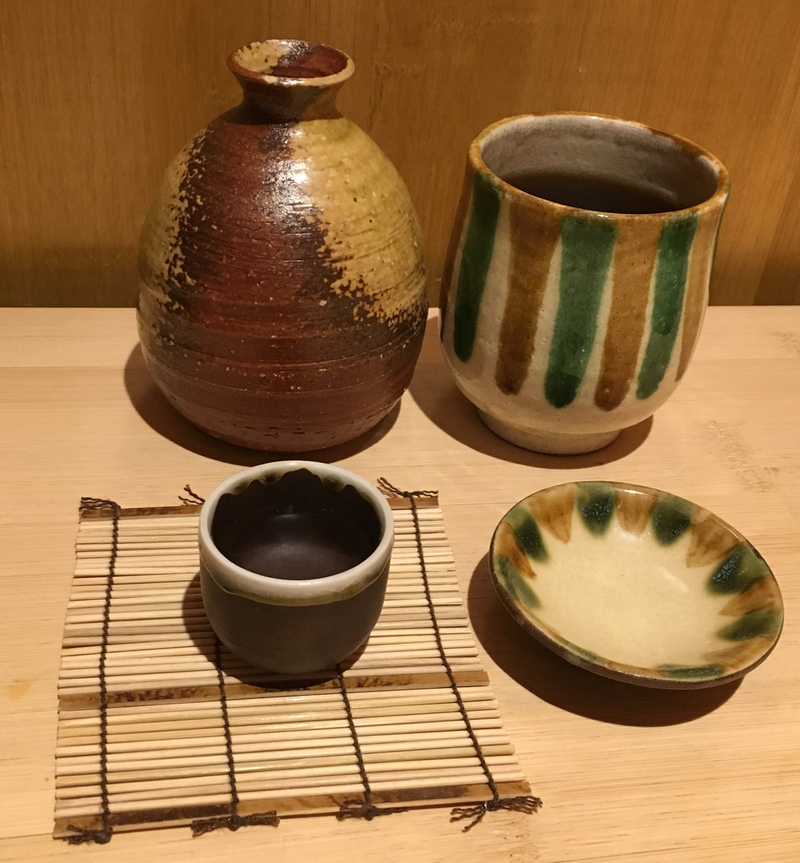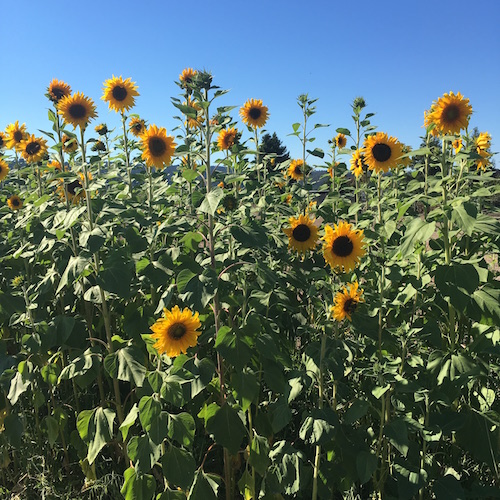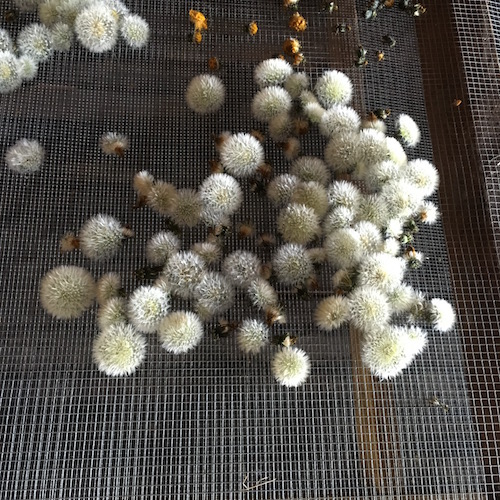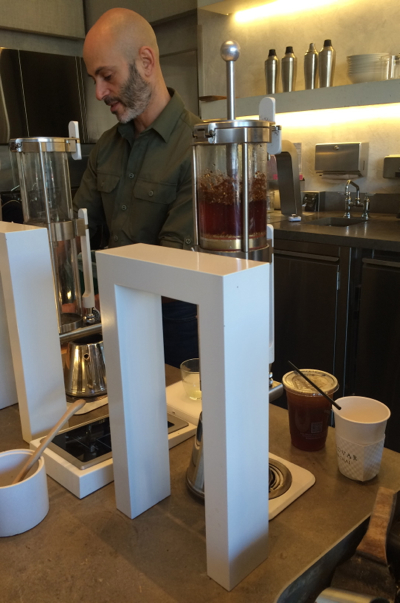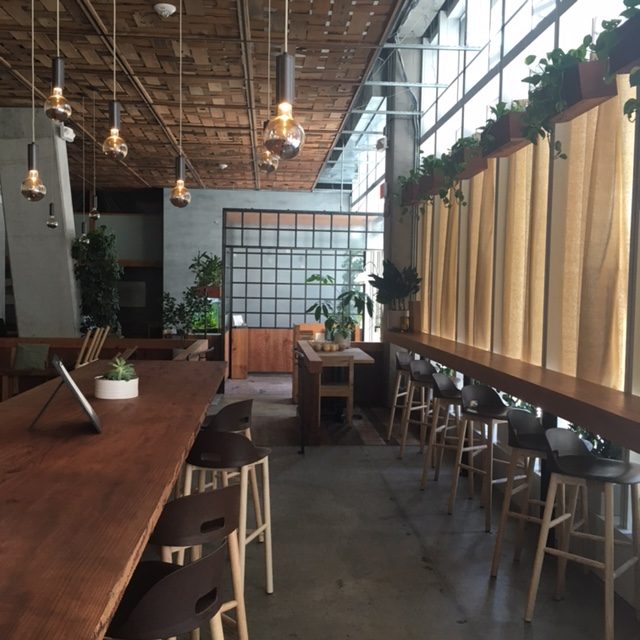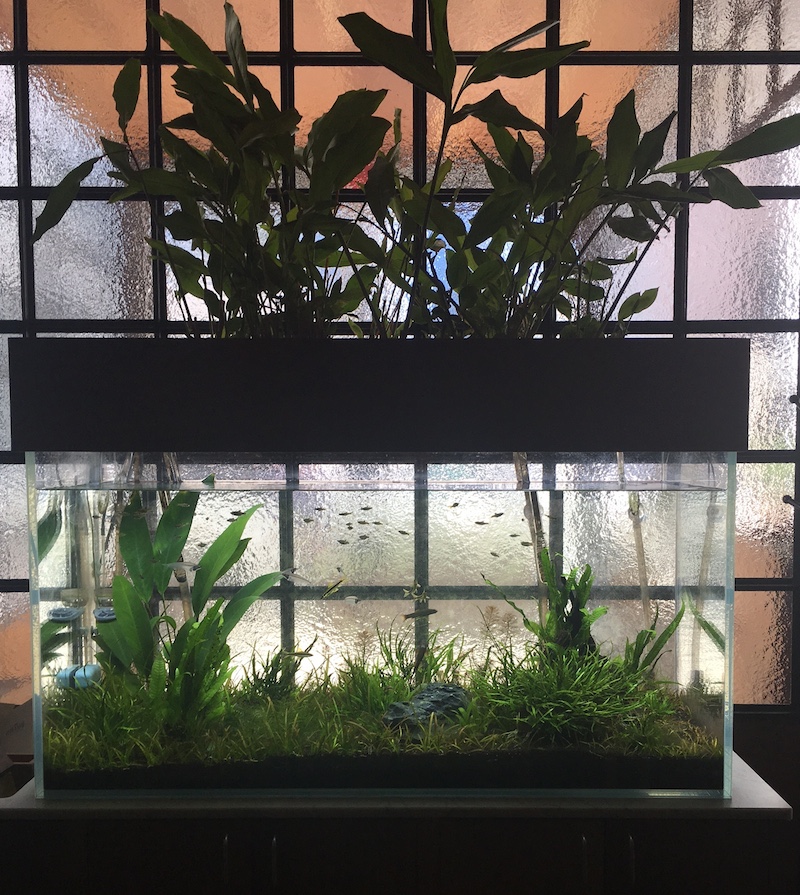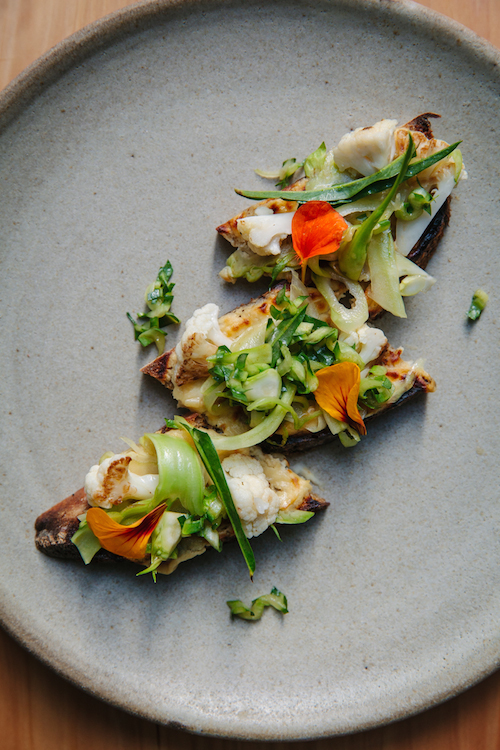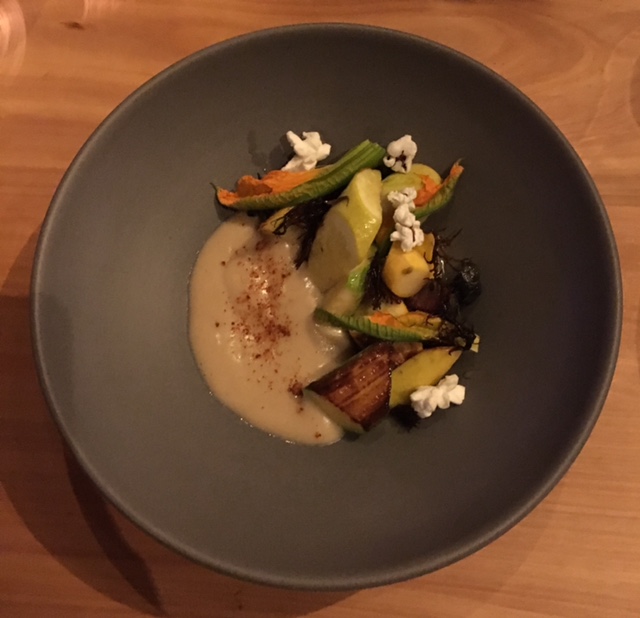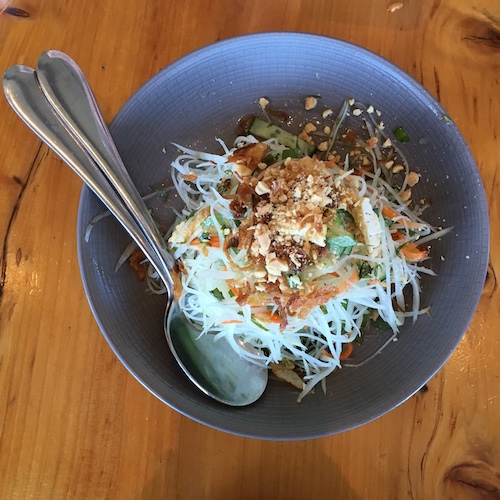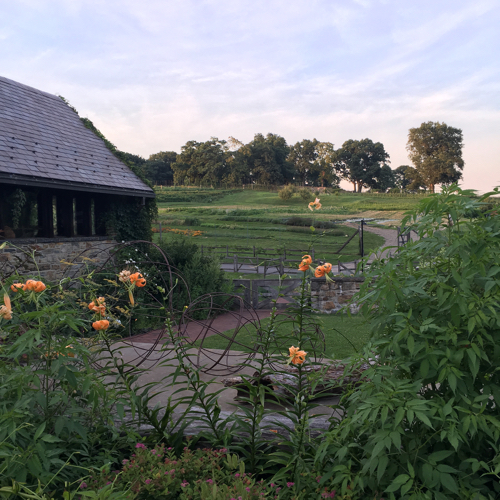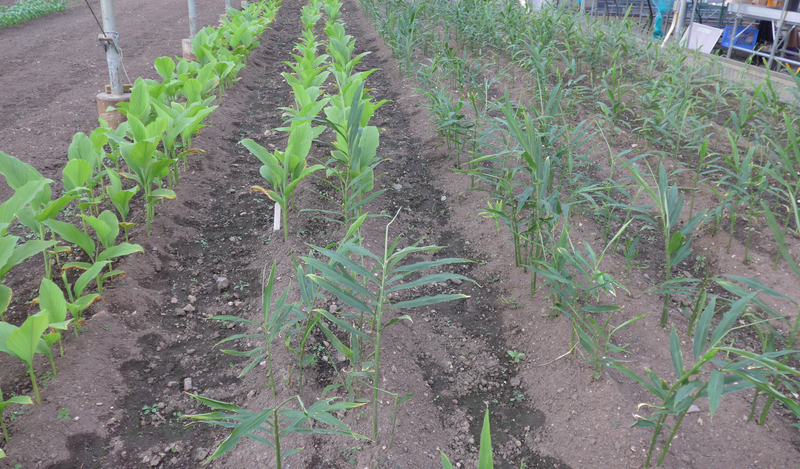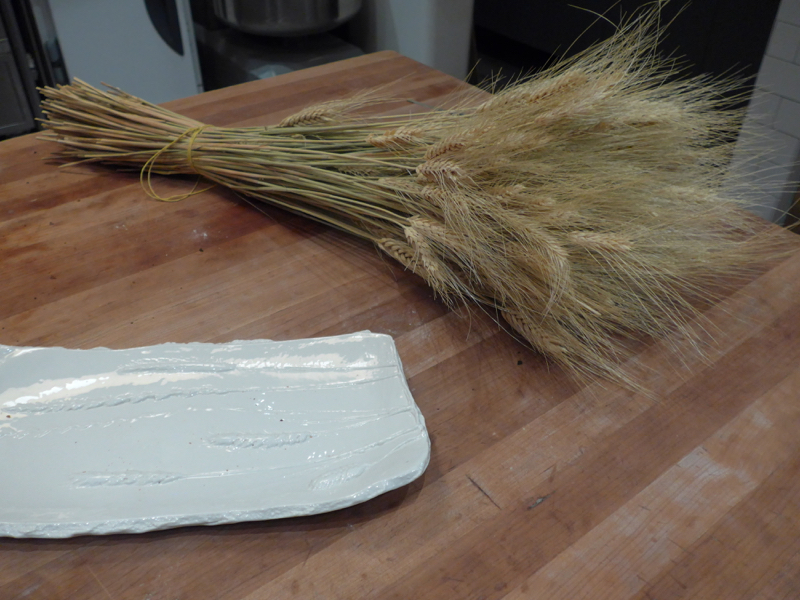Rouge Tomate Chelsea: sustainable fine dining setting precedent in New York
Rouge Tomate, the first vegetable-focused Michelin stared restaurant in New York switched coats for more casual, holistic, locavore and sustainable dining. Like the soon to be opened hyper locally seasonal Noma 2.0. in Copenhagen (cold-ocean, spring & summer – vegetables, forest produce and game takes over in the fall) Rouge Tomate 2.0. version was highly anticipated by many of its Manhattan fans. Wine streamed to the forefront at the healthy-minded contemporary bistro, and it is the rustic long bar that now welcomes the entrants to Rouge Tomate in Chelsea.


Primal, rustic and convivial scene
As you swish through the narrow corridor leading upstairs along a quirky mirrored artwork to the private dining room or turing sharply right behind the glass wall to the open bar scene and further back the restaurant itself, you realise that the bar in a hotel lobby like arrangement is the centre piece of the action. Rouge Tomate was set to be hip while keeping the relaxed conversation flowing with the juice of the Gods. Its primal theme resonates from the brick and recycled wood plank wall panels and the wooden bar, while the Asian feel casting retro chairs and living plant accessories tune to the established nature’s order louder. An english, earthy-hued tableware meets the current naturalistic dining trends.
Food at Rouge Tomate
Under the skilled chef’s hand of Andy Bennett, who headed the previous kitchen at Rouge Tomate, local, seasonal fruits and vegetables pop generously to the menu. “Responsibly-raised” seafood, fish, poultry and meat in smaller proportions than the usual protein-dominated plates join in. These are not just you regular tuna, salmon and chicken shipped from elsewhere, but sustainably line-caught and farmed animals. Rouge Tomato states that: “Our mission is to provide an extraordinary dining experience that supports the total well-being of the individual and the environment.” And, they fulfil this ethos to some degree. The menu is nutritionally balanced, the food is very good, in some plates excellent, but not extraordinary for the highly gourmandised Manhattan.
To start the snacking, the Anchovy with broccoli, sesame seed and white rice cracker is outstanding. The anchovies are not as salty in the smooth, creamy dip. Perfect with dry bubbles. The Red beet dip with flax crackers on the menu early on was not bad, a bit lighter.
Some starters are as big as the main courses or to be more precise as small to the grand America’s portion standards. I enjoyed the vegetarian Mushroom Tartare with fingerling potato, roasted garlic and watercress. Yet even better was the Fluke Crudo with uni (sea urchin), basil, kohlrabi, spiced up gently with some Thai chili. The Hawaiian Walu fish, also known as white tuna, escolar or butterfish is fatty enough to absorb good acidity so pineapple, lime and cucumber added freshness while avocado even more of the brain and heart healthful fat. The Venison Carpaccio with parsnip, wild mushrooms and huckleberries was the most disappointing plate because the meat was too chewy. It is so much better to air-dry the venison as they do in Switzerland. (check my Instagram).
If you went for fish or meat to start with, then choose from the vegetarian plates that grace the main options. In early spring you can find Roasted Carrot, quinoa with radicchio, coconut and spicy jalapeño, but I tried the generous Broccoli with walnuts, maitake mushrooms, sunchoke, Sarvecchio (American version of parmesan), and the lower in gluten spelt corzetti pasta (Ligurian coin-shaped pasta with embossed design on the face side).
As if I were at an American steakhouse looking for more veggies. These two sides were my dinner favourites: Kohlrabi seasoned with Chinese spice, fennel and sesame & Roasted Potatoes, garlic, capers and a drizzle of lemon. The Beets with sweet potatoes, peanuts and chiodini mushrooms were a bit too much to mix with any main course, unless you ordered them as a starter.
My husband was seduced by the Wild Boar served with cabbage, avocado and paprika spaetzle and by sampling it I can approve of it, although the boars from Tuscany tend to be even better, more tender. A friend ordered Chicken cut in small medallions with lentils, endive, harissa and hazelnut tzatziki, and by finishing her plate and nodding satisfyingly, you could say, well done!
The weekend brunch is also casually vibrant. The day light brings a different perspective to your meal. Brighter colours of the vegetables lure the fork in. The Roasted Carrots with shaved radishes, yogurt and orange sauces sprinkled over with poppy seeds were as refreshing as they were generous. Also the Cauliflower Salad blended with the creamy white and purply speckled sister of radicchio – Castelfranco, served with tart tamarind, fennel, emmer (ancient grain) and almonds was nice. Our brunch favourite at Rouge Tomate was the black Forbidden Rice spiced up with kimchi, sweet orange, bok choy and a sunny side up egg. Wholesome!
The American food icon, the burger, could not be left out, but the Bison Burger at Rouge Tomate is a healthier choice than the carbon demanding beef patty. For a hefty $17, the protein stuffed bun is joined by caramelized onion aioli and gem lettuce for a more green experience. I have not tried it yet, but let me know if you do!
To sweeten your day or night, the homemade sorbets and desserts based on nutritionally dense ingredients such as cocoa, ginger, fruit and vegetables will off-set at least some of the guilt. My summer dessert had pomegranate, hazelnuts and pear with a scoop of Earl grey Frozen Yogurt.
Environmentally speaking, an artisanal cheese can keep the carbon points quite low since it is locally (NW US) made by traditional methods. All the award-winning cheeses at Rouge Tomate are high in saturated fat and salt so enjoy with caution. The goat and cow’s milk blend of slightly aged Cremont “Cream of Vermont” made by Vermont Creamery, aged Prairie Breeze cheddar by Milton Creamery in Iowa and blue raw milk Bayley Hazen by Jasper Hill Creamery, all prove that America today makes as great cheese as France and the UK.
Sipping wine with Master Sommelier
The aperitif hours are hip, and there is much more to be sipped than some two dozen changing wines by the glass, since the house cocktails and exotic teas were well snug in.
Pascaline Lepertier, the French Master Sommelier and a partner in the business is the beverage director at the Rouge Tomate in Chelsea. Bringing her Loire-bred passion for natural, often biodynamic or organic, and by terroir driven wines, she vigorously gesticulates the process of opening and pouring the wine. There are other sommeliers with stellar resumes and the wine experience is indeed the centre piece of dining here, so make it your indulgent night out. We sipped on the 1998 Pinot Noir from Eyrie Vineyards. Another night the Calera’s Mills Vineyard of 2001 vintage showed the powerful grace of Mt Harlan California Pinot. Still, the young Burgundian bottles by Mugnier and Simon Beze & Fils stole the show. The 2008 Nuits Saint Georges and the daintier Savigny Les Beaune were poured during the previous night at one of the thematic wine events at Rouge Tomate. I advise subscribing to their newsletter for more info on these.
Tea has captured the beverage director at Rouge Tomate. The natural spirit of the leafy brew next to organic Korean herbal tisanes by Brooklyn-based Tea Dealers, is attractive. Some, like the White lotus or Mulberry leaf are sublime and easily likeable, while others taste rather medicinal. Its tuber is used in South American cooking, but having the intense Yacon leaves infusion with brunch, my curiosity was sated, yet I would not want this tart perennial plant brewed again. My liver and digestion were stimulated. One of my favourite herbal brews, the Wild Persimmon leaf, is more pleasant and smooth on the palate, is also offered. Unlike at most restaurants serving tea in America, multiple steeps are offered voluntarily.
Certified by the Green Restaurant Association with strict ecological standards as a three star establishment, Rouge Tomate also fully applies SPE standards (without being rated, because of the policy of affiliation), therefore rest assured that your wellbeing and the environmental impact are both taken seriously at this Chelsea hub of conviviality.
126 W 18th St, New York, NY 10011
+1 646 395 3978
Tue-Sun DINNER: 5:30 – 10:30PM; BAR: 5PM – midnight














